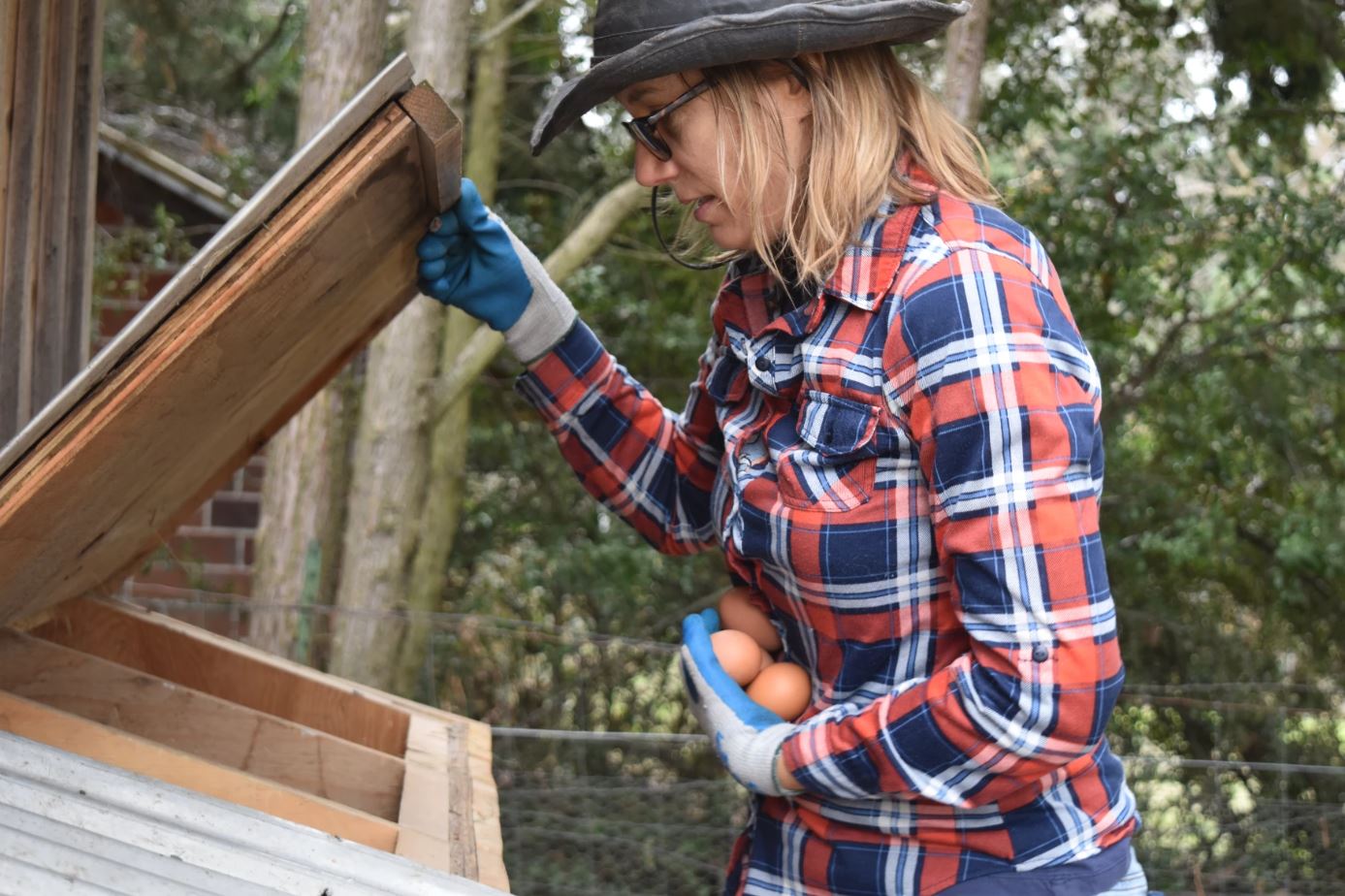
Diane Choplin gathers eggs at Bel Avenir Farm, her small operation in east Ashland, Ore.
Juliet Grable / JPR
In his drive to slash government spending, President Donald Trump has frozen or terminated millions of dollars in federal agriculture grant contracts. This is leaving farmers, ranchers, and landowners in Southern Oregon confused and worried.
On a Monday morning in early February, Diane Choplin wheels a bale of hay to a paddock on Bel Avenir, her farm east of Ashland, Oregon. Snow drapes the distant hills and birds chatter from the bushes as ewes crowd around; a few bleat softly as Choplin loads the feeder.
“These ladies were bred in November; they’ll lamb in April,” says Choplin. She’ll spend the spring moving the animals from paddock to paddock, making repairs, and booking the ewes’ “spa appointments” with the hoof trimmer. “Hopefully there won’t be any vet bills.”
Each ewe bears two or three offspring; in a good year, Choplin raises around 30 lambs. A mobile butcher comes to her farm to process the animals, which she sells directly to customers. She also sells pastured eggs.
Choplin started farming in 2012 because she wanted to provide a certain lifestyle to her son and produce sustainable, high-quality meat for her family and others. She never had any delusions about getting rich.
“It’s not a lucrative business,” she says. “Most farms are supported by off-farm income, including mine.”
Over the years, Choplin has taken advantage of conservation programs through Jackson County and the U.S. Department of Agriculture. Grant funding helped her install fencing so she can practice rotational grazing; another grant helped her restore a portion of Myer Creek, which runs through her property.
This year, thanks to a five-year grant through the Conservation Stewardship Program, Choplin was planning to hire an apprentice through Rogue Farm Corps. This incubator program allows young aspiring farmers to earn an hourly wage while gaining hands-on experience.

Diane Choplin checks on her pregnant ewes at Bel Avenir Farm. They’ll lamb in April.
Juliet Grable / JPR
Just as she was interviewing candidates, Choplin learned that executive actions had frozen or terminated millions of dollars in USDA grants. The funding freeze is tied to two executive orders signed by President Trump in January. One called for an immediate pause in the disbursement of funds appropriated through two laws passed during the Biden Administration. The second terminated any federal program or mandate tied to “diversity, equity, inclusion, and accessibility.”
Choplin thinks her grant might be funded by the Inflation Reduction Act, one of the Biden-era laws. She also worries certain “trigger words” in her contract could put her funding in jeopardy. “It mentions conservation and climate change, and it also prioritizes underserved producers,” she explains. “So there’s a lot of language in there that is risky right now.”
Choplin was looking forward to having full-time seasonal help. Among other things, she wants to remove invasive blackberries and launch a composting enterprise. This year’s grant pay-out was going toward her apprentice’s salary, but because funds aren’t disbursed until October, she’s decided not to proceed with hiring.
“I would be drawing from my savings to pay for the Rogue Farm Corps intern,” she explains. “If I don’t get that payment, I can’t pay my property taxes or hay.”
A diversity of producers and practices
Choplin is just one in Southern Oregon’s wide range of agricultural producers. While many grow hay and raise pasture animals, others grow mixed vegetables, fruit, seed crops, and flowers. There are also some small dairies.
The biggest struggle for small farmers and ranchers in this region is staying profitable, says Maud Powell, assistant professor at OSU Extension’s Small Farms Program. Sales increased for some producers last year, but those gains were offset by the rising cost of inputs like equipment, fuels and fertilizers, says Powell. “So the profitability is actually lower than it has been in the past, even though the markets are increasing.”
Federal conservation programs are offered through the Natural Resources Conservation Service, or NRCS. These popular programs help farmers implement practices that are better for the land, water, and wildlife — planting cover crops or preserving pollinator habitat, for example. These programs can also help farmers save costs or boost income. The “high tunnel” initiative, for instance, helps growers install hoop houses so they can extend the season.
Related: Black farmers among those left in limbo amid federal funding freeze
Federal conservation programs are typically funded through the Farm Bill, but starting in 2023, several received a significant boost of funding from the Inflation Reduction Act. Some of the new funding was used to hire more county agents, who work one-on-one with producers, helping them navigate grant applications and implement practices on the ground.
The funding freeze has plunged thousands of producers like Choplin into uncertainty — and in some cases, debt, says Jesse Womack, policy specialist at the National Sustainable Agriculture Coalition. “These programs by and large don’t hand out money to farmers upfront. [Producers] are being told that they might not be reimbursed for expenses they’ve already incurred.”
The freeze has not only frozen grant contracts, but any technical assistance tied to the Inflation Reduction Act. On top of that, USDA staff have been fired as part of the government-wide purge across federal agencies.
About 1,200 NRCS staff have been laid off so far, says Womack. “This is an agency that has been fighting tooth and nail to build up staff over the last four years, plus to try to recover from historically low staffing levels prior to the last administration.”
Supporting land stewards
Conservation programs don’t just support farmers and ranchers; they also help owners of forested property steward their land. Several years ago, the Greensprings, a rural mountain community southeast of Ashland, was identified as a priority for reducing “hazardous fuels.” Many property owners have taken advantage of the Environmental Quality Incentives Program, or EQIP, to thin trees, improve forest health and create wildlife habitat.

Rachel Knight stands in front of her home in the Greensprings. She and her husband have invested in a second parcel of land nearby and received a federal grant to create a firebreak along a road that cuts through the property.
Juliet Grable / JPR
Last year, extra funding through the Inflation Reduction Act opened up the program to more landowners. Greensprings residents Rachel Knight and Jacob Alheid purchased a forested tract two years ago. The 168-acre parcel was logged in 2017, and cedars and shrubs had grown in thickly.
“We snapped it up, knowing that it was a nice piece of land that could be really well managed if done right,” says Knight. “That’s where NRCS comes in.”
The couple was awarded a $14,000 grant to create a firebreak along the road that bisects the property. Knight was hoping to hire local labor to help with her project, but now, her funding is on hold. She worries about neighbors who may not be reimbursed for work they’ve already begun.
Jesse Womack with the National Sustainable Agriculture Coalition says the funding freeze affects entire communities. Grant money isn’t just used to purchase equipment or seeds, but to hire labor and expertise, he explains. “This is going to have huge economy-wide ripple impacts and really yank money out of the pockets of a lot of professionals in rural America.”
In the Greensprings, for example, many landowners have hired experienced local contractors like Lomakatsi or Brierville Fire & Forestry to carry out their contracts. It’s also unclear when or if Greensprings landowners will be able to apply for new grants, which could check the community’s collective effort to reduce the wildfire risk there.
Related: Many USDA researchers working in the Northwest are fired, worked on everything from hops to potatoes
Projects on hold
Not far from Diane Choplin’s farm, Chris Hardy walks along the road at Eagle Mill Farm in Ashland, checking on damage after a recent rare snowstorm. A large oak branch has snapped off near the road, but Hardy’s rows of grain seedlings look unscathed, aside from some nibbled plants at the end of one row. Tiny green shoots peek through straw.
Hardy is no stranger to extreme weather. “Last year we had 115 degree temperatures that hit our farm over in Talent and one of our other farm sites,” he says.
Hardy owns Hardy Seeds and has spearheaded the Rogue Valley Heritage Grains Project since 2019. Thirty local growers are helping him grow and propagate extremely rare grains gathered from all over the world. These include over 200 varieties of wheat, barley, oats, rye, emmer, spelt, einkorn, quinoa, sorghum, millet, upland rice, and other ancient grains. In some cases, they’re starting with a mere teaspoonful of seeds.
“We are working with drought tolerant, bio-regionally adapted varieties that can withstand the intense heat,” says Hardy.

Chris Hardy points out heritage grain varieties growing in his plots at Eagle Mill Farm in Ashland.
Juliet Grable / JPR
These growers were about to acquire processing equipment that would make their job easier. But, Hardy recently learned, a $200,000 grant that was going to be used to purchase the equipment is now on hold.
A second grant that Hardy Seeds was awarded through the Dry Farming Institute is also frozen. The grant supports a demonstration project where Hardy is testing a dozen varieties of heritage grains for drought resistance. He’s already planted out a quarter acre and acquired sensors that track moisture levels in the soil.
“And that’s just leaving us in a really challenging position right now,” says Hardy. “They’re saying, oh well, all that work you did, we can’t pay you for it.”
On Feb. 20, Agriculture Secretary Brooke Rollins announced that $20 million of frozen funds has been released, and that the agency will continue reviewing contracts tied to the Inflation Reduction Act. In a statement, NSAC notes that this tranche of released funds only represents about one percent of IRA-funded contracts for two popular conservation programs signed in 2023.
On Feb. 24, Oregon Sens. Ron Wyden and Jeff Merkley sent a joint letter to Secretary Rollins demanding that all of the funds be released and to restore “dedicated public servants” to their jobs.
Producers around the country, including Choplin and Hardy, have taken to social media to share their stories. Choplin hopes this crisis helps raise awareness of the value of conservation programs.
“Farm assistance programs allow a lot of small producers to keep producing,” says Choplin. “I couldn’t have afforded to do infrastructure and things that I did if these programs didn’t exist.”
Correction: This story has been corrected to reflect the fact that Rogue Farm Corps apprentices are paid an hourly wage, not a stipend, and that Bel Avenir Farm also receives money from Jackson County.
This story comes to you from the Northwest News Network, a collaboration between public media organizations in Oregon and Washington.
This republished story is part of OPB’s broader effort to ensure that everyone in our region has access to quality journalism that informs, entertains and enriches their lives. To learn more, visit opb.org/partnerships.


